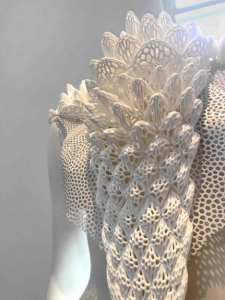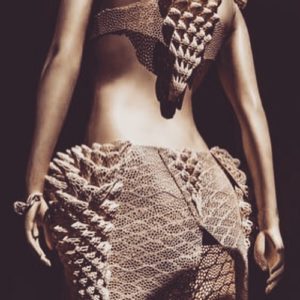Designer Uses Sustainable 3D Printing in Recent Exhibition Blurring the Lines Between Fashion and Art
 My wedding dress was so beautiful, I was almost afraid to touch it, much less wear it. Have you ever seen a piece of clothing, or jewelry, and thought that it was so striking it was an actual work of art? Thanks to innovative 3D printing technology, it’s not uncommon these days to see unique pieces of fashion that are so intricate and complex they almost belong in a museum.
My wedding dress was so beautiful, I was almost afraid to touch it, much less wear it. Have you ever seen a piece of clothing, or jewelry, and thought that it was so striking it was an actual work of art? Thanks to innovative 3D printing technology, it’s not uncommon these days to see unique pieces of fashion that are so intricate and complex they almost belong in a museum.
Italian designer Simone Leonelli, with the W230studio in Perth, West Australia, often uses 3D printing to make his pieces. Last month, Leonelli had a 3D printed fashion exhibition on display at the Perth Institute of Contemporary Arts (PICA) as part of the Telstra Perth Fashion Festival that blurred the lines between fashion and art.
“It is a ‘Fashion Total Look’ made by a desktop 3D Printer in order to push the boundaries of this process,” Leonelli told 3DPrint.com. “To summarise, this project is an exploration of fashion through the use of computational design and high-tech tools. In this instance, the fashion objects should be understood as architecture or as a design experiment.”
 The 3D printed fashion pieces – including shoes, a dress, and a bag – in the futuristic “Blurred Boundaries” exhibition were fabricated on an FDM desktop 3D printer, so that Leonelli could really “push the boundaries of open source tools.”
The 3D printed fashion pieces – including shoes, a dress, and a bag – in the futuristic “Blurred Boundaries” exhibition were fabricated on an FDM desktop 3D printer, so that Leonelli could really “push the boundaries of open source tools.”
Leonelli told Perth Underground, “The pieces on display resemble cell skeletons like Radiolarians and Diatoms; it just reminds you the beauty of the sea.”
The designer used both hardware and software to turn his unique design goals into reality. Rather than actual pieces of clothing a person could feasibly wear, he explained that the designs “should be understood as architecture or as a design experiment.”
“The designs have been inspired by biological structures such as mineral cell skeletons, and the complexities were created with the help of computational design processes,” Leonelli told us. “The forms are not driven by imitating nature specifically, instead they are human interpretation of the way in which nature designs itself.”
 The exhibition as a whole is an exploration of biological structures, fashion, and technology. Leonelli used biodegradable PLA material, a bioactive and renewable thermoplastic, for most of the 3D printed parts, due to his passion for sustainable design.
The exhibition as a whole is an exploration of biological structures, fashion, and technology. Leonelli used biodegradable PLA material, a bioactive and renewable thermoplastic, for most of the 3D printed parts, due to his passion for sustainable design.
“The potential of 3D printing is incredible, and when combined with the power of computational design the user will experience a very flexible and scalable technology,” Leonelli explained to 3DPrint.com.
He said that if he had used traditional methods of manufacturing, like milling or injection molding, instead of 3D printing, he would not have been able to produce the complex, non-standard shapes he was looking for.
“The beauty of working with these high-tech tools is the possibility of working without following a standard workflow or hierarchy. You can for example, create a design using the whole or part of the human body, and move back and forth through the workflow with 3D scansion,” Leonelli told us.
“You can even jump from one part of the workflow timeline to another with a great deal of flexibility and degrees freedom. 3D print manufacturing makes creative ideas simple to produce. It is currently one of the most efficient ways to transform design ideas into products.”
During Leonelli’s free exhibition last month, PICA’s education program, Spark_Lab, also set up some simple activities related to “Blurred Boundaries” so younger visitors would be able to appreciate the exhibition while also stimulating their curiosity and their creativity.
What a perfect day to come and see us @pica_perth !the are many reasons why you wouldn't miss this exhibition:_THAT'S JUST THE BEGINNING!!! 3D printing in fashion is still an exotic concept, but you should get ready to see a lot more of them in the next future._WATCH THE REVOLUTION!!! 3D printers build objects by depositing layers of melted plastic one on top of the next, the layers fuse together in a manner wholly unlike the way fibers become fabric…and then you've just that to wear your design. _CARE FOR OUR ENVIRONMENT!!! The goal is create a sustainably printed collection and to start experimenting new fabric and processes which have less negative impact on the Earth._JUST IMAGINE!!! Imagine going on holiday with an empty suitcase, checking out the vibe on arrival, then printing out the perfect outfit. Such a delicious possibility. We’re probably far away from becoming part of your holiday packing strategy, but let's start to familiarize with the idea!
Posted by W230 on Friday, 8 September 2017
What do you think of the exhibition? Discuss this and other 3D printing topics at 3DPrintBoard.com, or share your thoughts in the Facebook comments below.
Subscribe to Our Email Newsletter
Stay up-to-date on all the latest news from the 3D printing industry and receive information and offers from third party vendors.
You May Also Like
Precision at the Microscale: UK Researchers Advance Medical Devices with BMF’s 3D Printing Tech
University of Nottingham researchers are using Boston Micro Fabrication‘s (BMF) 3D printing technology to develop medical devices that improve compatibility with human tissue. Funded by a UK grant, this project...
3D Printing Webinar and Event Roundup: April 21, 2024
It’s another busy week of webinars and events, starting with Hannover Messe in Germany and continuing with Metalcasting Congress, Chinaplas, TechBlick’s Innovation Festival, and more. Stratasys continues its advanced training...
3D Printing Webinar and Event Roundup: March 17, 2024
It’s another busy week of webinars and events, including SALMED 2024 and AM Forum in Berlin. Stratasys continues its in-person training and is offering two webinars, ASTM is holding a...
3D Printed Micro Antenna is 15% Smaller and 6X Lighter
Horizon Microtechnologies has achieved success in creating a high-frequency D-Band horn antenna through micro 3D printing. However, this achievement did not rely solely on 3D printing; it involved a combination...
































